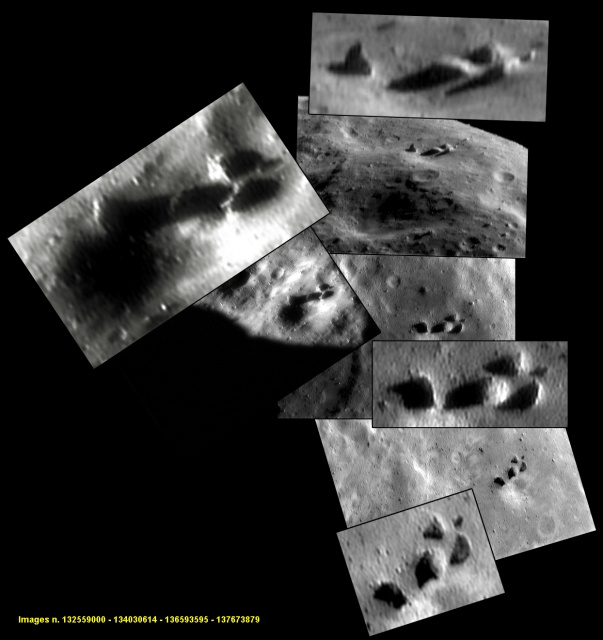
March 28, 2012
Credits: NASA - NEAR Project - Arizona State University; Credits fo the additional process. and color.: Elisabetta Bonora/LXTT/IPF
|
433-Eros is a so-called "Near-Earth Asteroid" (or NEA) which was discovered in the AD 1898 by the German Astronomer Carl Gustav Witt, and it was also the first Asteroid to be orbited by a man-made Spacecraft (such as the NASA - NEAR Shoemaker Probe in the AD 1998 and 2000). 433-Eros is an S-type Asteroid whose dimensions are (approximately) 34,4 × 11,2 × 11,2 Km in size, which makes it the second-largest NEA after 1036 Ganymed; it also belongs to the "Amor" Group of Asteroids (the Amor Asteroids are a group of Near-Earth Asteroids all named after the Asteroid 1221 Amor; these Asteroids approach the orbit of the Earth from beyond, but do not cross it. Most Amor Asteroids, however, do cross the orbit of Mars and the two moons of the Red Planet, Deimos and Phobos, may actually be two former Amor Asteroids that were captured by Mars' Gravity). 433-Eros, as a matter of fact, is a so-called Mars-Crosser Asteroid and it was the first known to come within the orbit of Mars periodically. It must be said, though, that objects like 433-Eros and all the Amor ones, can keep a relatively stable orbit for a period of "only" a few hundred Million Years, before their Celestial Path gets irreversibly perturbed (or actually disrupted) by gravitational interactions. Many Scientists who have deeply and cerefully studied the orbit of 433-Eros believe that it may evolve into an Earth-Crosser Asteroid some day, within an interval as "short" as about 2 Million Years. This last fact makes 433-Eros a potential Earth Impactor (an Impactor that is believed to be larger than the one which created the Chicxulub Crater, such as a prehistoric Impact Crater buried underneath the Yucatàn Peninsula). As we already mentioned hereabove, the NASA - NEAR Shoemaker Probe visited 433-Eros twice: first with a 1998 Fly-By, and then by orbiting it in the AD 2000, when the NASA - NEAR Shoemaker Probe, among others, carried out an extensive photographic coverage of its Surface. On February 12, 2001, at the end of its mission, the NASA - NEAR Shoemaker Probe landed on the Asteroid's Surface but, unfortunately, no signal was ever received on Earth afterwards (most likely because of the occurrence of a so-called "rough landing", which maybe caused severe - and of course unrepairable - damages to the antenna or to some other of vital components of the Probe). Whereas the Surface Gravity of any given Celestial Body depends on the distance from a single spot (located on the Surface) to the center of the Body's Mass, we can assume that the 433-Eros' Surface Gravity varies greatly from place to place, since this Asteroid is not a sphere, but rather an elongated potato-shaped object. The daytime temperature on 433-Eros can reach about 100° C at Perihelion, while nighttime measurements make it fall near -150° C. 433-Eros's density is approx. 2400 Kg/m3, which is about the same Density of the Earth's Crust. 433-Eros rotates once every 5,27 hours. NEAR scientists have found that most of the larger rocks strewn across 433-Eros were ejected from a single Crater that might have been created through a Meteor Collision occurred approximately 1 Billion Years ago. This impact may also be responsible for the fact that roughly 40% of the Surface of 433-Eros is devoid of Craters smaller than 0,5 Km across. It has to be said that, originally, several Scientists thought that the Debris thrown up by the Collision, actually filled-in the smaller Craters and - in a way... - erased them. However, an analysis of the Crater Densities all over the Surface of 433-Eros indicates that the areas with lower Crater Density are all within 9 Km from the alleged original Impact Point. Some of the lower Density areas, instead, were found on the opposite side of the Asteroid, but still within 9 Km from the original alleged Impact Point. It has been theorized, so, that Seismic Shockwaves may have propagated throughout the whole body of the Asteroid, shaking (better yet: reducing the) smaller Craters into rubble. Since 433-Eros is irregularly shaped, a 9-Km straight line passing all the way through it can obviously reach locations that would otherwise be much further away and, very likely, unreachable by the Shockwaves themselves (if they had travelled, instead, ONLY across its Surface). The Rocky Outcrop that is shown in the image-mosaic of today's APOD is located on the Surface of 433-Eros at approx. 14,46° North Lat. and 256,77° East Long. Some pseudo-Researchers and UFO-Fans speculated for a long time about the true nature of the Asteroid as well as about the nature of this specific Surface Feature, but the only undisputed fact we have today, is that all we are looking at, is just a group of four irregularly shaped and semi-buried Boulders. |
News visualized: 728 times

